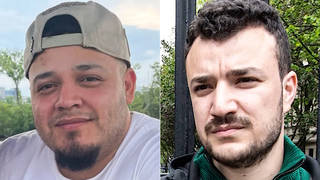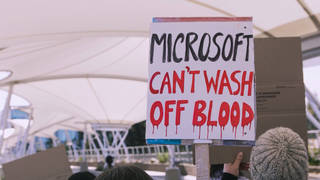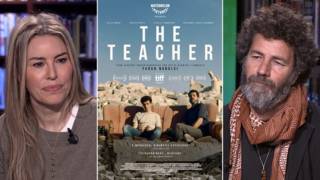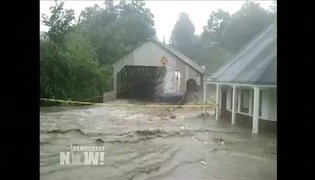
Guests
- Bill McKibbenco-founder and director of 350.org. He is author of Eaarth: Making a Life on a Tough New Planet.
- Greg Jonesclimate scientist and professor of environmental studies at Southern Oregon University in Ashland.
Much of the East Coast is shut down today as residents prepare for Hurricane Sandy, a massive storm that could impact up to 50 million people from the Carolinas to Boston. The storm has already killed 66 people in the Caribbean, where it battered Haiti and Cuba. “This thing is stitched together from elements natural and unnatural, and it seems poised to cause real havoc,” says Bill McKibben, founder of 350.org. New York and other cities have shut down schools and transit systems. Hundreds of thousands of people have already been evacuated. Millions could lose power over the next day. Meteorologists say Sandy could be the largest storm ever to hit the U.S. mainland. The megastorm comes at a time when President Obama and Republican challenger Mitt Romney have refused to make climate change an issue on the campaign trail. For the first time since 1984, climate change was never addressed during a presidential debate. “It’s really important that everybody, even those who aren’t in the kind of path of this storm, reflect about what it means that in the warmest year in U.S. history, … in a year when we saw, essentially, summer sea ice in the Arctic just vanish before our eyes, what it means that we’re now seeing storms of this unprecedented magnitude,” McKibben says. “If there was ever a wake-up call, this is it.” We’re also joined by climate scientist Greg Jones from Southern Oregon University. [includes rush transcript]
Transcript
AMY GOODMAN: We’re on the road in Medford, Oregon, broadcasting from Southern Oregon Public Television.
Much of the East Coast is shut down today as residents prepare for Hurricane Sandy, a massive storm that could impact up to 50 million people from the Carolinas to Boston. New York and other cities have shut down schools and transit systems. Hundreds of thousands of people have already been evacuated. Millions could lose power over the next day. The storm has already killed 66 people in the Caribbean, where it battered Haiti and Cuba.
Meteorologists say Sandy could be the largest ever to hit the U.S. mainland. While not as powerful as Hurricane Katrina, the storm stretches a record 520 miles from its eye. Earlier this morning, the National Hurricane Center said the hurricane’s wind speed increased to 85 miles per hour with additional strengthening possible. Describing it as a rare hybrid “superstorm,” forecasters say Sandy was created by an Arctic jet stream wrapping itself around a tropical storm. The storm could cause up to 12 inches of rain in some areas, as well as up to three feet of snowfall in the Appalachian Mountains. Flooding is also expected to be a major problem. The National Weather Service has warned of record-level flooding and “life-threatening storm surges” in coastal areas. The Nuclear Regulatory Commission has announced it’s taking special precautions for the storm. There are at least 16 nuclear reactors located within the path of the storm. Six oil refineries are also in the storm’s path.
While the news media have been covering Hurricane Sandy around the clock, little attention has been paid to the possible connection between the storm and climate change. Scientists have long warned how global warming would make North Atlantic hurricanes more powerful. Just two weeks ago, the Proceedings of the National Academy of Sciences published a major study on the connection between warmer sea surface temperatures and increase in stronger Atlantic hurricanes. The report said, quote, “In particular, we estimate that Katrina-magnitude events have been twice as frequent in warm years compared with cold years.”
We begin today’s show with two guests. With me here in Oregon, we’re joined by Greg Jones, climate scientist and professor of environmental studies at Southern Oregon University in Ashland. And joining us by Democracy Now! video stream is Bill McKibben, co-founder and director of 350.org. He’s author of numerous books, including Eaarth: Making a Life on a Tough New Planet. On November 7th, 350.org is launching a 20-city nationwide tour called “Do the Math” to connect the dots between extreme weather, climate change and the fossil fuel industry.
We welcome you both to Democracy Now! Let’s start with Bill McKibben. Bill, you’ve just made it back to Vermont, to your home. Can you talk about the significance of what the East Coast is facing right now?
BILL McKIBBEN: Well, I think, Amy, that the first thing is this is a storm of really historic proportion. It’s really like something we haven’t seen before. It’s half, again, the size of Texas. It’s coming across water that’s near record warmth as it makes its way up the East Coast. Apparently we’re seeing lower pressures north of Cape Hatteras than have been ever recorded before. The storm surge, which is going to be the very worst part of this storm, is being driven by that huge size and expanse of the storm, but of course it comes in on water that’s already somewhat higher than it would have been in the past because of sea level rise. It’s—it’s a monster. It’s—Frankenstorm, frankly, is not only a catchy name; in many ways, it’s the right name for it. This thing is stitched together from elements natural and unnatural, and it seems poised to cause real havoc. The governor of Connecticut said yesterday, “The last time we saw anything like this was never.” And I think that’s about right.
AMY GOODMAN: There certainly was a lack of discussion, to put it mildly, in the presidential debates around the issue of climate change.
BILL McKIBBEN: Yeah.
AMY GOODMAN: I don’t think it was raised at all in the three debates.
BILL McKIBBEN: How do you think Mitt Romney is feeling this morning for having the one mention he’s made the whole time? His big laugh line at the Republican convention was how silly it was for Obama to be talking about slowing the rise of the oceans. I’d say that’s—wins pretty much every prize for ironic right now.
There has been a pervading climate silence. We’re doing our best to break that. Yesterday afternoon, there was a demonstration in Times Square, a sort of giant dot to connect the dots with all the other climate trouble around the world. Overnight, continuing in Boston, there’s a week-long vigil outside Government Center to try and get the Senate candidates there to address the issue of climate change.
It’s incredibly important that we not only—I mean, first priority is obviously people’s safety and assisting relief efforts in every possible way, but it’s also really important that everybody, even those who aren’t in the kind of path of this storm, reflect about what it means that in the warmest year in U.S. history, when we’ve seen the warmest month, July, of any month in a year in U.S. history, in a year when we saw, essentially, summer sea ice in the Arctic just vanish before our eyes, what it means that we’re now seeing storms of this unprecedented magnitude. If there was ever a wake-up call, this is it.
AMY GOODMAN: Let me play the clip you’re referring to of Mitt Romney at the Republican convention in Tampa.
MITT ROMNEY: President Obama promised to begin to slow the rise of the oceans and to heal the planet. My promise is to help you and your family.
AMY GOODMAN: That was Mitt Romney at the conventions, but—at the Republican convention. But again, when it came to the presidential debate, neither President Obama nor Mitt Romney raised the issue of climate change. I wanted to bring Greg Jones, climate scientist and professor of environmental studies here at Southern Oregon University in Ashland, into the conversation. The connection between the superstorm we’re seeing and climate change?
GREG JONES: Well, this is clearly a very unique event. And I—as a climate scientist, to some degree, I kind of worry that these type of unique events are clearly more frequent in the future. We have the conditions that have produced something that could be very damaging for the East Coast of the United States, and I often wonder why we don’t seem more of them. But, you know, the question is, today is, is that where we are in terms of our climate science understanding of these things, the rarity of this event is what makes it very unique. And I think all of the conditions came together to produce a superstorm. And we’ve had a few that have been close to this, but given the number of people involved and the location where it’s coming onshore, it’s a very problematic event.
AMY GOODMAN: Bill McKibben, what do you think has to happen now? You have been traveling the world, warning people, working with organizations around the issue of climate change. Do you feel like the kind of organizing you’re doing has an effect? I mean, you see these three presidential debates. Tens of millions of people watch them. They sort of define the discourse in this country. And yet, not raised in any—it’s not only the candidates don’t raise them, the reporters who are the moderators of these debates don’t raise the issue.
BILL McKIBBEN: Look, we’re up against the most powerful and richest industry on earth, and the status quo is their friend, and they want nothing to change. And until we’re able to force them to the table, as it were, very little will happen in Washington or elsewhere. That’s why we launched this huge tour, beginning the night after the election, not coincidentally, in Seattle and continuing around the country. You can find out about it at math.350.org. But the point is that we really finally need to have this reckoning. Either the fossil fuel industry keeps pouring carbon into the atmosphere and we keep seeing this kind of event, or we take some action.
Here’s the thing always to remember. The crazy changes that we’re seeing now, the—you know, the fact that we broke the Arctic this summer, the fact that the oceans are 30 percent more acid, that’s all that’s all happened when you raise the temperature of the earth one degree. The same scientists who told us that was going to happen are confident that the temperature will go up four degrees, maybe five, unless we get off coal and gas and oil very quickly. And to do that, you know, it’s nice to talk to Washington, but in certain ways Washington has turned into customer service for the fossil fuel industry. It’s time to take on that industry directly.
Not time today. Time today is to take care of people all up and down the East Coast, to work in the relief efforts, to get the message out as this storm heads north. We in Vermont, knowing from last year, from last year’s superstorm, Irene, have a pretty good idea of just how traumatic this is going to be. So the short-term effort is all about people. But the slightly longer-term effort is to make sure that we’re not creating a world where this kind of thing happens over and over and over again.
AMY GOODMAN: Bill, you mentioned that the storm is made up of elements both natural and unnatural. What do you mean by that?
BILL McKIBBEN: Well, look, I mean, global warming doesn’t cause hurricanes. We’ve always had hurricanes. Hurricanes cause when a wave, tropical wave, comes off the coast of Africa and moves on to warm water and the wind shear is low enough to let it form a circulation, and so on and so forth. But we’re producing conditions like record warm temperatures in seawater that make it easier for this sort of thing to get, in this case, you know, up the Atlantic with a head of steam. We’re making—we’re raising the sea levels. And when that happens, it means that whatever storm surge comes in comes in from a higher level than it would have before. We’re seeing—and there are a meteorologists—although I don’t think this is well studied enough yet to really say it conclusively, there are people saying that things like the huge amount of open water in the Arctic have been changing patterns, of big wind current patterns, across the continent that may be contributing to these blocking pressure areas and things that we’re seeing. But, to me, that, at this point, is still mostly speculation.
What really is different is that there is more moisture and more energy in this narrow envelope of atmosphere. And that energy expresses itself in all kind of ways. That’s why we get these record rainfalls now, time after time. I mean, last year, it was Irene and then Lee directly after that. This year, this storm, they’re saying, could be a thousand-year rainfall event across the mid-Atlantic. I think that means more rain than you’d expect to see in a thousand years. But I could pretty much—I’d be willing to bet that it won’t be long before we see another one of them, because we’re changing the odds. By changing the earth, we change the odds.
And one thing for all of us to remember today, even as we deal with the horror on the East Coast, is that this is exactly the kind of horror people have been dealing with all over the world. Twenty million people were dislocated by flood in Pakistan two years ago. There are people with kind of existential fears about whether their nations will survive the rise of sea level. We’re seeing horrific drought not just in the Midwest, but in much of the rest of the world. This is the biggest thing that’s ever happened on earth, climate change, and our response has to be the same kind of magnitude.
AMY GOODMAN: Bill McKibben, why are you waiting ’til after the presidential election to have your 20-city tour raising the issue, calling it “Do the Math”?
BILL McKIBBEN: Well, I mean, we’ve been involved as we can be in the political fight, but we don’t want this issue to go away when elections are over. Even if Barack Obama wins, we do not want everybody to just, “Oh, well, he’ll take care of it.” That’s what happened four years ago. What we want is for—no matter who wins and no matter who wins in the Senate and the House, we want to put the fossil fuel industry front and center and put real pressure on them. We’re going to try and launch a divestment movement that looks like the one around South Africa a quarter-century ago. We’re going to be bringing home the math that I described in a piece in Rolling Stone this summer that went kind of viral, explaining that the fossil fuel industry already has five times more carbon in its inventory than even the most conservative government thinks would be safe to burn. And every day, they go out looking for more. This is a rogue industry now. I mean, if Sandy is a rogue storm, then, say, Exxon is a rogue industry. They, in their inventory alone, have more than 7 percent of the carbon necessary to take us past two degrees. They’re outlaws not against the laws of the state, but against the laws of physics. And you begin to see the results of that when you look around events like today’s.
AMY GOODMAN: Bill McKibben, I want to thank you for being with us. And very quickly, how are people in Vermont preparing? I mean, when—when Hurricane Irene hit, it ended up not being a very big deal in New York, but it ended up being a massive catastrophe for your state, for Vermont. What’s happening? How are you preparing here?
BILL McKIBBEN: [inaudible] in Vermont in a very long time. We’re expecting to lose power and have very strong winds. I think, selfishly, those of us in Vermont are just almost psychologically—I’m—you know, we really, really, a year later, don’t need to be the center of this storm. We don’t wish it on anybody else, but, you know, physically and psychologically, Vermont’s barely recovered from Irene. And we have some incredible sense of sympathy for the people who are getting hammered hardest by Sandy this time around.
AMY GOODMAN: Well, I want to thank you, Bill McKibben, for being with us, founder of 350.org, speaking to us from his home in Vermont. When we come back, we’ll stay with Greg Jones, climate scientist, professor of environmental studies here at Southern Oregon University in Ashland, and we’ll be joined by meteorologist Jeff Masters. Stay with us.












Media Options